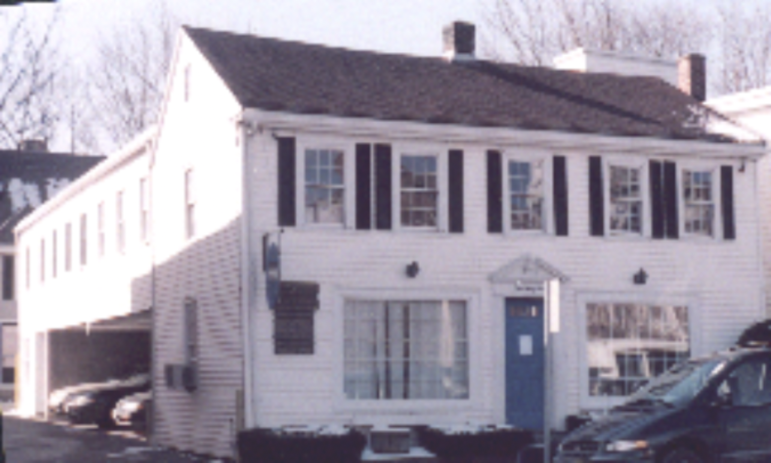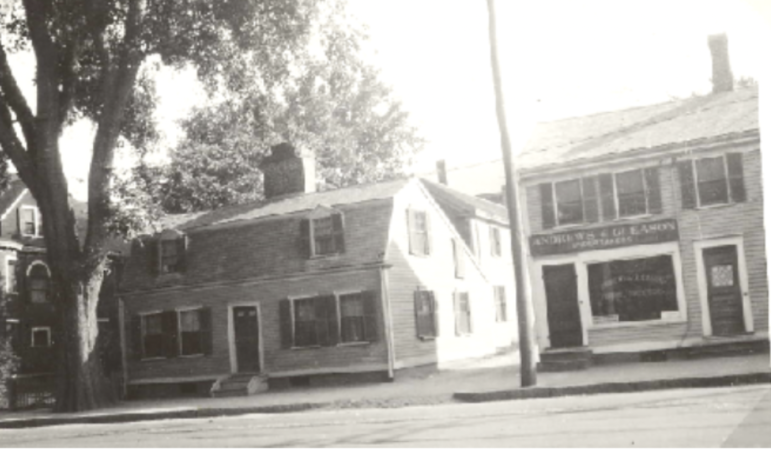
This article is part of a series on local history provided by the Historical Society of Watertown. It was written by Joyce Kelly, Board member of the Historical Society of Watertown. Joyce writes articles for the newsletter and is the newsletter editor. This was published in our April 2004 newsletter, “The Town Crier”.
134 Main Street
Although many of the old houses of Watertown have been demolished to make way for “progress,” a few of these treasures have been saved by caring individuals with a soft spot for days gone by and an interest in what happened in the past.
In 1982, through funds provided by the United States Department of Housing and Urban Development, the Watertown Historic Resources Inventory was compiled by employees of the Architectural Preservation Associates of Cambridge, Massachusetts. This Inventory identifies buildings that contribute to or illustrate the growth of Watertown and the development of its architecture. Two of the houses listed in this report will be discussed in this quarter’s newsletter:
The law offices building at 134 Main Street is one of the oldest colonial structures in Watertown Square still standing, dating back to 1785. The owner of the building, Attorney Steve Winnick, was very interested in its history when he bought it back in 1982 and has done extensive title research, reaching back to when the property was owned by Bezaleel Learned, a farmer, and
sold to William Leathe, a blacksmith, in 1781.
Bezaleel was the son of Thomas Learned, who, among other trades, ran a tavern on Main Street in the vicinity where Spring Street is now located.
The title states that Learned sold Leathe “two thirds of a quarter of an acre by estimation” for 60 pounds. Both of these men are listed in “Watertown’s Military History” as serving in the Revolutionary War.
A building was constructed on this property and William Leathe ran his blacksmith shop out of the first floor of the building and lived upstairs. In 1800 Leathe sold “one quarter of an acre of land by estimation with a dwelling house and other buildings thereon standing” to his son, William Jr. a baker. This section of Watertown was one of the earliest to be developed commercially. Main Street was a principal thruway. Stagecoaches and wagons passed by daily and travelers stayed overnight at the many taverns that dotted the street.
After William’s death, the property was sold again in 1825 to Francis Leathe, perhaps a brother, but most certainly a relative. In 1841, a fire broke out one night between midnight and one in the morning in Francis Leathe’s bakery at the corner of Church and Main Streets. The stables of the Spring Hotel next door were burned. The Unitarian Church, where Reverend Convers Francis preached, also burned to the ground. The fire was still raging at 3:00 AM. The Boston Traveler reported this fire to be the worst blaze in Watertown’s history as of that date. (The First Parish Unitarian Church was rebuilt. The new striking wooden gothic structure stood on Church Street until its demolition in 1975.)

Francis Leathe died circa January 1842. His will makes specific reference for building and finishing a new house upon the foundation of the one recently destroyed by fire. The house was rebuilt at a cost of $2,370.15. Obviously, many buildings in Watertown Square were affected by the great fire of 1841.
After changing hands a couple of more times, the property was sold to Patrick Loftis and James Hughes in 1863. They sub-divided the property – Loftis taking the front part of the property facing Main Street, and Hughes taking the back part of the lot. Easement and well rights are referred to in the deed as “being laid out by the parties to this deed as a passageway for the use in common of the two estates.” This parcel of land is described as “forever the right at all times of passing and repassing on foot or with carriage over a strip of land 12’ in width and 74’3” deep…”
The right of passage is still in effect today.
In 1864, Loftis sold his parcel of land with a dwelling house to Catherine Richardson. A Street Directory from 1874 lists her husband, Peter, as running a hotel called the “Shamrock House” at this location. These names call attention to the increase of Irish immigrants that had begun to settle in Watertown.
In 1878 the property was sold to John Gleason and in 1917 to Patrick Gleason. In 1920 it was sold to William Andrews. A Street Directory from 1917 lists “Andrews and Gleason – Undertakers” at this location.
For much of the time between World War I and 1971, this property was used as an undertaker service and later, for a short period of time, a funeral home. During this time and the years before, wakes were conducted in people’s houses. The preparation of the body and the viewing would all take place in one’s home. As the practice of viewing the body in a funeral parlor became more popular, the business at this location tapered off. The building was very small and could not accommodate a large number of people.

In 1971 the property was sold to Edward Kavenagh, who made use of it as law and insurance offices.
In 1982 the property was sold to Steve Winnick, the present owner, who has turned the building into law offices. The building was in disrepair when he bought it. Winnick gutted and reconstructed the inside of the building and renovated the outside. During these rebuilding efforts, charred timbers were discovered. Perhaps the charring of the timbers occurred during the great fire of 1841.
In 1986, Winnick tore down the red barn on the back of the property and built an L-shaped addition with parking underneath.
The dates and ownership transfers listed in this article were all researched by Steve Winnick, who took a great interest in the history of this property when he bought it. I thank him for his help with this story.
The Watertown Historic Resource Inventory lists upward of 100 buildings with their descriptions and some of their history. A copy can be viewed at the Watertown Free Public Library in the Reference Department on the second floor or online at https://mhc-macris.net/
Wonderful story. Thank you for sharing Watertown’s history.
Not a colonial structure if built in 1785. U S was no longer a colony as of 1776.
I certainly hope this building survives all the big development planned for Main St. There should be a plaque listing the history of the building either on the building or some kind of signage next to it. Watertown has not done a good job of preserving much of its history over the years. We have few historic homes and businesses compared to other old cities and towns around us.
From what I understand, the block that is scheduled to be demolished for a new, modern-looking FIVE STORY building with very little green space, and probably without a Post Office, has a great amount of history that few people are aware of. There should also be a plaque placed near there to inform people of the key people and businesses that helped to establish our town/city.
Thanks for your comment, Joan. The historic house is next to the building that is proposed to be torn down, but is not part of that project.
Thank you, Joyce, well done. Thank Charlie for publishing and recognizing Joyce, and all of the members, for their years of work.